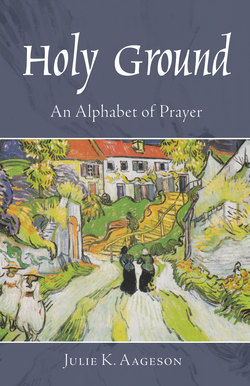Читать книгу Holy Ground - Julie K. Aageson - Страница 9
На сайте Литреса книга снята с продажи.
Attention
Оглавление“Listen up!” I used to say to my students and later on to my daughters. “Let me see your eyes.” I wanted their complete attention, their ears and their eyes. I expected them to stop what they were doing and focus on what was about to be shared. I wanted them to be present and to take notice. Giving one’s attention to something implies courtesy and consideration, perhaps even thoughtfulness and responsiveness. Attention is a way of being present, a form of prayer.
Several years ago I was invited to write a monthly column for a denominational magazine. The invitation was a surprise and I was both honored and a bit frightened at the prospect of writing about a spiritual practice I did not claim to understand or do particularly well. I could recall the faithful prayers of my grandparents, those regular devotional times around the tables of my growing up, prayers said routinely at bedtime and mealtime, and prayers for specific situations and people. But this invitation to the holy ground of prayer required careful and honest attention.
Layered on top of that insecurity were the deeper issues of what prayer is, how prayer is practiced, and an all-too-ubiquitous understanding of prayer as an exchange of ideas or a list of requests or a private means of accessing God. I had always found deep meaning in the prayers of the liturgy and corporate worship. If I could somehow define prayer as paying attention, listening for God’s voice in others and in the ordinary events of daily life, I could write honestly and authentically—even in a monthly magazine with regular deadlines.
As my narrower understanding of prayer became more expansive, I began to pay attention to God’s presence in less linear and carefully defined ways. Perhaps it was related to becoming a mother and finding ways to pray—to be—in the midst of endlessly long days and too many sleepless nights. Or perhaps it was a lifelong awareness of the mystery of God’s presence, inexplicably compelling, irritatingly tenacious, a perpetual mindfulness that demanded attention.
Prayer became for me a way of looking at the world—a place, an attitude, a stance; not so much an action as the living presence of God within us. Possibly that is what it was all along. But the common definitions which seemed to me what others more disciplined and pious called prayer were not often my experience.
Do you remember a children’s television program called Mr. Roger’s Neighborhood? Fred Rogers was a tall, lanky fellow whose soft voice and ways of paying attention to the smallest things were not easily forgotten. In contrast to a lot of children’s programs or to almost everything else that seeks to demand our attention, Mr. Rogers invited children and adults to notice things: a warm sweater he donned at the beginning of each program, a neighbor who needed help, birds that welcomed food in the wintertime, flowers beginning to break through the soil to seek the warmth and light of the sun, a pair of sneakers that protected his feet, each of the children who watched his programs and what it was they were feeling that day—nearly 900 programs over several decades meant to help children pay attention.
Perhaps adults liked Mr. Rogers because they too wanted to pay attention. They recognized his regard for even the smallest things. Together with children whose eyes and ears sometimes notice and pay attention to things adults take for granted, Mr. Rogers methodically honored the world God has given us by paying attention.
Pay attention to the reflections in Holy Ground: An Alphabet of Prayer. They are invitations to think more broadly about the practice of prayer. Pay attention to all the ways God speaks and acts. Pay attention to praying without words, being present, practicing silence, listening. Pay attention to the holy ground where you are. Notice the world around you. See your place in the world with fresh eyes. Look and feel and listen to God’s voice within you and within others. Attention—mindfulness—will help illuminate the living presence of God within us: much more, much beyond, and much closer than we sometimes think God to be. I hope this God who defies our paltry definitions and categories will continue to become the lens through which we see ourselves and this earth we call home.
Let us pray with our eyes and our ears and our hands. Let us take notice of one another, of the things we carry and bear. Help us attend to daily life, to the presence of ordinary rhythms and the extraordinary ways they convey God’s love and grace. Help us honor the world and the holy ground where we live by being mindful, paying attention, being present. O God, make us attentive.
REFLECTION
Prayer became for me a way of looking at the world—a place, an attitude, a stance and not so much an action as the living presence of God within us. I want us to think about the deeper issues of what prayer is, how prayer is practiced, and an all-too-ubiquitous understanding of prayer as an exchange of ideas or a list of requests or a private means of accessing God.
What are some ways you pay attention to God’s presence in less linear and defined ways?
How have your notions of prayer changed?
How do you understand the view that attention—mindfulness—illuminates the living presence of God within us?
Let us pray with our eyes and our ears and our hands. Let us take notice of one another, of the things we carry and bear. Name some ways you pay attention to praying without using words.
Beauty
